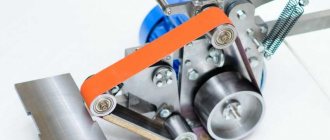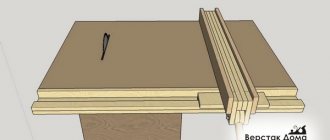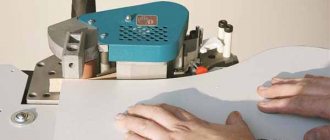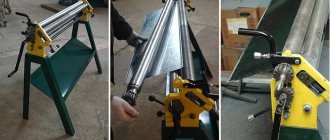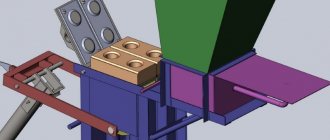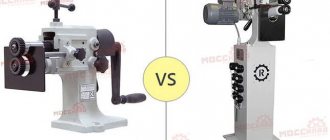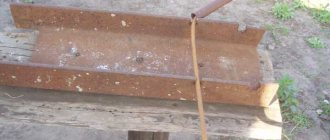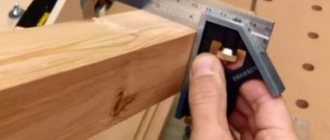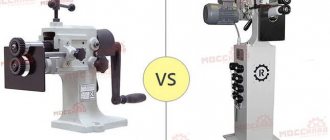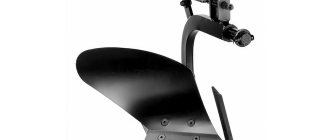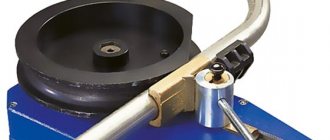Homemade jigsaw attachments
It often happens that the file moves to the sides when using a jigsaw.
To prevent this from happening, you can use a homemade nozzle. For the workpiece we need a file in the shape of a triangle. There is a shank made on it, just like on the file itself. Simply insert it into the power tool and start working. You can also create a shank from a round file. To do this, cut the file to the length of the saw. Using a grinding machine, we orient it along the edge and grind down the unnecessary metal to 1.5 mm thickness or another size depending on the type of device. After that, insert it into the hole of the jigsaw, and you can start working.
You can also make a saw for a jigsaw. To do this, we will need a regular jigsaw file so that we can use it to make a blank from the panel. Her main functions are cutting wood and cutting metal. First, using a ruler, we divide the workpiece into two equal parts, after which we go deeper and draw 2 lines.
Using two cutters, we make a break along the cut and get a pair of blanks. One of them is intended for working with wood, and the other for working with metal. Now we apply the file to the workpiece and repeat the contours. You should cut out a place for the lock where the jigsaw file will be attached, and mark the length.
To learn how to make a jigsaw from a sewing machine, watch the video below.
How to improve the design?
Of course, a manual jigsaw is not perfect, but it can be modified and brought to perfection.
- A rocker is being made. This type of structure will be tensioned using springs on one side and secured to the file on the other.
- We fasten the file between two rollers. Their function is to be guides.
- We use a factory jigsaw as a drive. A file is pulled between it and the rocker.
Note!
Do-it-yourself compressor: TOP-130 photo reviews of finished compressors. Step-by-step instructions + diagrams and drawings
Do-it-yourself wind generator: TOP-170 photo reviews of finished devices. Detailed DIY instructions for beginners
Do-it-yourself spot welding - the best master class on making homemade spot welding with step-by-step photo diagrams of do-it-yourself work
Tool selection
To choose a good machine suitable for solving specific problems, you need to pay attention to its power. The majority of models are equipped with an electric drive with a power of 90 to 500 W
For home use, the optimal power is 150-200 W.
An important selection criterion is the presence of two operating speeds of the unit. In the standard version - 600 and 1000 rpm. This makes it possible to select the appropriate mode for working with materials of different densities.
The desktop can be fixed or rotating. Fixing the table at an angle allows you to cut material at specified angles other than 90°. There are also models that provide table height adjustment - this allows you to extend the service life of the file, since you can use different sections along its entire length for work, and not just the central part.
Manufacturers equip jigsaw machines with a variety of options, including:
- a compressor to remove chips from the marking line with a stream of air;
- drilling block;
- illumination of the work area;
- guarding the blade (will not allow your fingers to come into contact with the moving saw);
- clamping device (prevents vibration of sheet material of small thickness).
Model range of jigsaw machines
Most often, machines differ in their electric drive power; the range of values is huge: from 90 to 500 W.
These devices are also divided into varieties based on their fundamental design:
- universal;
- on suspension;
- with graduation;
- with the caliper in the lower position;
- with double caliper.
Jigsaws with lower support
Diagram of machine design elements.
The most used and popular models are machines with lower support. Their feature is the division of the working bed into upper and lower parts.
If in the upper section there is only one device for sawing and cleaning, then in the lower section there are many working elements: an electric motor, a switch, a transmission unit and a control unit. This design makes it possible to saw sheets of materials of almost any size.
Double slide machines
A homemade jigsaw with a double support differs from the lower support by the presence in the upper section of a special additional bar and a work table with the ability to change the angle of inclination and overall height.
These models are designed to work with oversized parts. This machine is easier to make than the previous model. There are restrictions on the materials that can be worked with: their thickness should not exceed 80 mm.
Hanging machines
The name speaks for itself: the model is movable, it works without a stand. The fundamental point in this design is the movement of the cutting file, and not the consumables. The module itself is attached to the ceiling, the saw is driven manually.
All this provides serious advantages: in this way you can create the most complex patterns, the surface dimensions are not limited in any way.
Devices with graduation
The presence of stops and a degree scale make it possible to work according to technical drawings, without the slightest error.
Universal machines
Such devices are usually called jigsaws. Their feature is the ability to perform several operations such as grinding, polishing, sawing, etc.
How to make a machine from a hand jigsaw?
Let's consider the procedure for making a jigsaw machine. The design consists of a work table with a jigsaw attached to the bottom. The rocker consists of a rigidly reinforced post with a movable spring-loaded lever. This option is considered affordable and reliable, devoid of unnecessary components and parts.
For simplicity and clarity, it is recommended to sketch out working drawings that will clarify some design features and answer questions regarding dimensions, connection points and other details of the assembly process.
The creation of a machine can be divided into three stages, which should be considered separately:
Preparatory stage
Before starting the actual manufacture of the machine, it is necessary to make some preparation. First of all, you should make a special adapter for installing the file. In most jigsaws, the seat end of the file is inserted into a socket and clamped with a screw.
The cutting element of the machine is a thinner and longer file with holes at the ends, which are placed on special pins (or through which mounting screws pass). Therefore, it is necessary to make an adapter, the lower part of which copies the shank of a standard file for a given jigsaw, and the upper part is equipped with a hole for a screw with a nut, with which the adapter is connected to the bench saw.
Here the procedure is not limited in any way - some grind a part of the desired shape from a metal plate, others take a piece of a finished file with a shank and weld a steel washer to it, followed by processing for accuracy.
In addition, you need to prepare the necessary tools and materials, including:
Figure 3 – Drawing of a jigsaw machine
- Bulgarian;
- electric drill with a set of drills;
- screwdriver;
- welding inverter with electrodes;
- pieces of chipboard or multilayer plywood for the desktop and bed;
- connecting corners;
- fasteners (self-tapping screws or bolts with nuts).
This list is not exhaustive; additional tools or materials may be needed.
Creating blanks
The first step will be to make a desktop. A piece of plywood or chipboard of the planned size is sawn off. There are no special restrictions here, but you will have to take into account the size of the room in which the machine will be placed. A table that is too small will be inconvenient for working with large parts, and too much table space will take up a lot of space in the room (or workshop).
As a rule, when choosing the size of the table, they are guided by the size of the parts that will be processed on the machine. Holes are made on the table for attaching a jigsaw and for a file. To do this, unscrew the sole from the tool, apply it to the table and mark the centers of the holes for the connecting bolts.
Figure 5 – Jigsaw beam
The second step will be making the rocker arm. It will require two elements:
- rack;
- movable lever.
For the stand, take a profile pipe of rectangular cross-section and weld a support platform at the bottom.
Its size should ensure immobility, stability and reliability of the rack during operation under load.
The height should correspond to the length of the file in the maximum raised state, plus a small margin for the size of the attachment point.
The best option is that in the middle position of the saw, the movable lever is in a horizontal position.
The moving element is a beam mounted on a rack using a hinge joint. The length of the front part ensures that the saw blade attachment point is positioned exactly above the corresponding jigsaw element. The back of the lever is connected to a spring that provides tension.
Then you need to make a tension unit. It is a regular spring, which is tensioned using an adjusting screw. It is attached to one end of the spring, threaded through a special loop on the frame and tightened using a nut and washer.
Assembly
The assembly process is not difficult. You need to do the following:
- Connect the work table and the bed.
- Install the jigsaw.
- Secure the stand with bolts.
- Install the lever.
- Attach the tension spring and secure on both sides.
If the calculations were performed correctly, the file will move exactly vertically without yawing to the sides. It is recommended that before starting the jigsaw, check its progress and make sure that no unforeseen situations are expected.
Homemade jigsaw for polystyrene
Assembling a fairly convenient and reliable device for cutting thin pieces of wood and polystyrene. This method is almost similar to the previous one, but has a more functional design. There is no need to write a detailed description of how to make this electric jigsaw with your own hands, since the design of the device is similar to the previous assembly. We will provide a complete list of necessary materials and tools for manufacturing.
- Plywood 200x200x5 mm
- Wooden block – 120x50x50
- Spatula or sheet of metal, 1 mm thick
- Metal terminal for connecting wires
- Metal rod (spoke)
- Hacksaw blade
- Electric motor (DC) 12 volt
- A piece of thin, flexible plastic
- Fastening metal corner
- A piece of PVC pipe as a handle
- Contact closure button
- 12 volt power supply with DC plug
- DC power connector
- Self-tapping screws, bolts and nuts
The above list of materials is only a subjective choice of the author of the instructions and does not claim absolute accuracy.
When you make something with your own hands, you need to improvise and come up with creative uses for various parts. If you don't have an element in stock, perhaps someone else can handle its function. By instruments:
- Needle file
- Metal scissors
- Pliers
- Drill or screwdriver with a set of drills
- Core drill for wood with a diameter of 44 mm
- Saw
- Soldering iron
- Thermal gun
To more clearly understand the process of assembling all of the above elements, watch the detailed video “how to make a jigsaw with your own hands.” Most questions related to the design of the device will disappear by themselves.
There is also another option for making a homemade jigsaw.
The operating principle of this product is similar to the previous two; there are some nuances in the design. We hope that the following video will be useful and give you fresh ideas for creating your own instrument. article from the Rating section
- 0
Power tools Do-it-yourself tools Carpentry tools (for wood)
Save this page on your social media. network and return to it at any time.
ADD A COMMENT
How to make your own installation
The desire to create a homemade jigsaw may arise for several reasons:
- There is no power supply in the workshop, but it is possible to use low-power internal combustion engines.
- There are pneumatic motors, but the compressor power is not enough for a serial tool.
- The electric motor is powered by batteries or solar panels; the power of the source is not enough to use a power tool.
- It is required to obtain saw motion parameters that are unattainable using a commercial tool.
Designing a jigsaw is not difficult. A typical structure looks like this:
The installation is easy to adapt to any torque source. A pair of pulleys (one is located on the engine shaft, the other drives the crank mechanism) allows you to vary the gear ratio, reducing the load on the power unit and allowing you to get the required speed (they are also responsible for the number of saw strokes per minute) on the actuator.
A machine built according to the above scheme can have a very different configuration; the material of manufacture is also selected individually. An example of a finished installation looks like this:
How to make a jigsaw with your own hands?
The easiest option is to make a machine. A homemade jigsaw is probably a better solution. There are a great many variations and drawings, they are easy to find on the Internet. This is all a consequence of the desire to create a unique and inimitable instrument. However, the operating principle will always be absolutely the same.
Remaking the place where the needle is attached to the file
There is a threaded hole in the working rod of the machine that allows you to attach a saw locking mechanism. There are several options for such homemade devices, but the most durable and reliable is a tube placed on a rod and secured to it with a bolt. To do this, a hole is made in the upper part of the tube for a bolt, which is screwed into the hole on the rod. Another hole is made in the lower part of the tube, into which an M3 or M4 thread is cut.
The file is inserted into the tube and securely fixed with a screw. This mounting method is the easiest, but some users still find it unreliable. Therefore, there is another option - instead of a tube, take a rod with a diameter of 10-12 mm, drill a hole at one end for the rod and a transverse hole for fixing the saw holder on the rod. To install the file, a slot is made in the longitudinal direction, into which the file is inserted. It is fixed with a bolt, which is screwed into the prepared threaded hole.
Making a jigsaw from a sewing machine is a simple and short process. The result will be the appearance of a convenient and compact device that allows you to accurately and accurately cut complex curved shapes. To increase the service life of the file, you can use additional pieces of chipboard, which are placed on the work table and, as the quality of sharpening decreases, are removed. The area through which the blade cuts the workpiece changes, and sharp teeth are used again. This procedure can be done several times.
Reworking a rod from a broken factory-made electric jigsaw
Having finished disassembling the sewing machine, I started working on the rod from the broken jigsaw. It had to be cut, removing the excess part, and then mounted in a new place. To do this, I measured about a third of the entire length from the saw clamp, marking the cut location with a marker.
It is only at first glance that it seems that the rod of the electric jigsaw is all-metal. In fact, it is a hollow tube that is quite easy to saw off with a regular hacksaw. But at the same time, in order not to waste extra force on the steel core located inside it, it is better to rotate the tube. And when it is completely sawn, simply remove it from the core. I used a grinder: what’s the point of wasting extra time?
Marking the location of the cut on the rod from the broken electric jigsaw
Installing part of the jigsaw rod on a sewing machine
The rod was cut off, and now all that was left was to install it on the sewing machine. To do this, it was necessary to drill a hole with a diameter of 3 mm both on it and on the machine rod. This is where you had to be careful. The drill had to go exactly perpendicular to the canvas. Also on the machine rod - exactly parallel to its axis. A mark was made on the sawn part at a distance of about a centimeter from the edge.
In order to drill the hole correctly, I used a machine. If there is none, I advise you to clamp the part in a vice. Before starting work, it is worth marking the drilling point. Otherwise, the drill will slip off the rounded surface of the rod.
The drilling location is marked, you can proceed
After both holes were ready, the rod from the broken jigsaw was put on the same part of the sewing machine, the holes were aligned, and the elements were fixed with a bolt and nut. Of course, I could have spent a little more time (perhaps I will do so later) to cut the threads in the holes. This will secure the connection even more reliably. However, even after the thread is cut to the required diameter and the screw is screwed into it, you should not neglect the additional nut on the back side. Still, the speed will be high, and the workload will be quite significant.
We fix the connection with a bolt and nut and pull it through
Jigsaw for precision sawing
The old masters said -
- a person capable of sawing at right angles is called a cabinetmaker - therefore, all sorts of crooked-armed sawers out there are not one, but they can, if desired and diligent, learn to “straight saw.”
The bulk of electric jigsaws are used for direct sawing (only a few are used, for example, for slotting wood carving), but the sellers managed to instill in us the idea that this is a special type of tool that can first be cut crookedly, and then leveled with other more advanced tools , but this is advertising, by the way, there is a very good song by Shaova T.S. “About advertising,” because dentists in all countries recommend shit to us, it doesn’t sink, it doesn’t burn, it will last a very long time.”
In order for a jigsaw to cut smoothly, you need to understand the reason why it cuts crookedly, and it is very simple, when long rods are compressed, their stability is lost, that is, they are bent, in our case, the rod is a jigsaw file and its curvature from compression is the main reason for the violation of straightness cut (it goes without saying that our file is symmetrical and its plane of symmetry coincides with the plane of movement - the feed of the jigsaw, all backlash is minimal)
Naturally the question is - What to do?
The answer should be addressed to manufacturers of jigsaws from all countries, unfortunately, the average user will not be able to fix it unless he makes the CORRECT pendulum stroke himself, and what we are used to calling the pendulum stroke of saws would be more correctly called the “manufacturers’ shit motion,” if we call things by their proper names life will be cleaner.
However, let’s return to the loss of stability of the files and how to deal with it -
— when sawing, the file must experience MINIMUM compressive loads, for this purpose when lowering it down
No. 1, you should ensure that it is pulled back at a speed exceeding the forward feed speed of the jigsaw,
No. 2 it is necessary to ensure that at this moment the saw teeth do not touch the wood
Then it will be
1 lack of resistance to its downward movement,
2 no compressive force,
3 no bending force
as a result, there is no loss of stability of the file due to compression when lowering it down,
When the file is raised upward, sawing occurs and bending and tensile forces arise in the file, while the tensile force can somehow reduce bending deformations, this is especially important for narrow blades.
This all together is called the CORRECT pendulum stroke; to implement it, no pushing roller is needed, since the roller can only push the saw forward and cannot pull it BACK; instead of the rod, you should attach a connecting rod to the rod that will push it forward and pull it back
Modified March 4, 2021 by Our Teacher
Parts for electric jigsaw
When assembling an electric jigsaw, it is important to find a suitable motor that will drive the working tool - the saw. A motor from a drill, blender, food processor or other equipment of the same type is perfect for this purpose.
It is better to make the jigsaw frame from aluminum pipe.
The movable frame is made of metal profiles, wooden slats or slats made of durable plastic. It is most convenient to work with aluminum tubes of square section, since they are easy to process, have low weight and a significant margin of safety.
To fix the jigsaw in the desired position, you should make a reliable frame for it from wood or metal. The dimensions of the frame do not have much impact on the operation of the jigsaw. They depend only on which version of the tool you need - a compact tabletop or a full-size one installed on the floor.
The jigsaw table is made from a thick sheet of plywood, in which a small diameter hole is made where the file will move (Fig. 2).
There is also a simpler option on how to make a homemade jigsaw. It consists in the fact that a hand-held electric jigsaw is mounted in a vertical position on a table-stand, while its file is tensioned to the movable guide bars - levers.
Scope of application
The special design and thin saw blade make the tabletop jigsaw a unique device, indispensable when performing certain types of tasks. This device has gained the greatest popularity in the woodworking industry. It is often used in delicate work to make jewelry, souvenirs, musical instruments and furniture.
One of the main features for which the wood jigsaw is so valued is the ability to carry out internal cuts on the workpiece without damaging its contour. Not the least role in the usefulness of this device is played by its ease of use, when both hands of the operator are free and can best control the position of the product on the working surface. To everything else, it is worth adding the accuracy of the resulting cutting line, as well as the ability to work with plastic and metal. All of the above advantages make a table jigsaw the best tool for cutting out decorative elements.
Design and characteristics of a standard machine
A factory-made jigsaw is a reliable device, the operation of which is guaranteed by the manufacturer. Manual models are low cost. Stationary devices are expensive, but provide proper comfort when processing wood. The set of components in the device is largely the same for everyone.
The design consists of the following parts:
- Files.
- Crank assembly.
- Drive.
- Devices for tensioning the file.
- Work table or bed.
- Additionally, auxiliary mechanisms may be present.
The part to be processed is placed on the work table. The size of the workpiece depends on its dimensions. Some models have a rotary table, which makes working with the part easier and improves visibility. The presence of graduations makes it easier to mark the material.
Average characteristics of factory machines:
- The table size ranges from 30 to 40 cm. This is the optimal size.
- The drive has a power of about 150 W. This is an achievable value for a homemade device.
- The rotational motion is converted into reciprocating motion by the crank mechanism. Then the force is transferred to the saw.
- The file has an oscillation frequency of 800 to 1 thousand per minute. The vertical amplitude of movement usually does not exceed 5 cm. Some models have adjustment of the speed of movement, which allows you to adapt to the properties of the material.
- A manual band jigsaw allows you to work with plastic and wood no more than 10 cm in thickness. The length of the parts should not exceed 35 cm.
- There are many types of saws, which vary depending on the material being processed. The width of the file ranges from 2 to 10 mm.
- The uniform operation of the file is ensured by its tension mechanism. It consists of coil or leaf springs.
Models for specialized purposes may have radically different characteristics. There are small size specifications for processing small parts. As well as models of large sizes, the industry also produces them for retail sale. But such options will be very expensive.
In the middle class there is high competition for consumers, so the devices will be cheaper. The characteristics are also tailored to the typical tasks of a carpenter. Based on them, you need to make drawings of a jigsaw machine with your own hands. Complex components for it are purchased in the store.
Jigsaw machine from a washing machine engine
In a homemade design, the drive can be different - at the discretion of the master. Let's consider the option of using a standard motor from an automatic washing machine.
Let's get to work. First you need to make a jigsaw machine bed.
You can use different materials - whatever is available. In this case, the author welded a frame from a strip of metal and a profile pipe.
The design is very simple: you need to make legs from a profile pipe, and from a strip you need to make a frame and an upper frame for attaching the desktop. At the bottom, a bracket is welded from a strip of metal to which the crank mechanism will be attached.
The first version of the tabletop jigsaw used a factory mechanism from a sewing machine. In this case, we will make this unit with our own hands.
First you need to make an eccentric shaft. On a lathe we turn a shaft of the required shape from a steel round timber.
We put a bearing on one end of the shaft, after which it will be necessary to weld a piece of round steel offset from the center.
Cut a piece of round pipe that will serve as the body. We insert the shaft inside it and put the bearing on the other end.
A metal strip with a movable (hinge) element is attached to the eccentric. We weld another piece of strip to the body.
A guide for the moving element is welded to this plate.
The next step is to weld the homemade crank mechanism to the frame.
A holder for a jigsaw file must be welded to the movable element (rod), which moves up and down.
After this you will need to make a desktop. What material to use is at your discretion. Ideally, it is better to use sheet metal. But plywood or chipboard will also work.
You need to make a hole in the work table for the saw blade.
As in the previous case, it is necessary to make a bearing block. We weld it to the L-shaped post. But in this case, the stand is made not from a profile pipe, but from a strip of metal. And the stand itself is welded directly to the frame.
At the last stage, it is necessary to weld the support platform for the electric motor, and you can start painting.
A pulley is placed on the eccentric shaft. We install the engine from the washing machine and connect its shaft to the eccentric one using a belt drive (belt).
How to make a jigsaw machine with your own hands is shown in detail in the video below. The idea was shared by the author Mr Novruz.
For convenience, it is better to place the engine on/off button on the side of the frame, as close to the workplace as possible. In general, the design is very simple, and repeating it will not pose any problems.
Making a jigsaw with your own hands
A homemade machine, made to replace a conventional jigsaw for wood, is capable of ensuring high-quality performance of the basic set of operations for shaped cutting of sheet materials. Depending on the purpose, you can design a compact electric model or a stationary unit designed for high loads.
Materials
As a basic diagram, it is most convenient to use a drawing of a simple wooden jigsaw with a flywheel and pedal assembly and replace the mechanical drive with an electric one. If the machine is intended to be used only occasionally, you can do without a special electric motor. Instead, connect any suitable power tool. It is convenient to use a screwdriver with adjustable rotation speed.
The material used to manufacture the machine itself is wood, and:
- it is better to make the frame and the supporting pedestal for the lever bar from high-strength plywood (minimum thickness - 18 mm);
- for a lever structure, you need to take dense wood that is not prone to cracking under load - beech or oak (instead of buying bars, you can use straight legs of old chairs of suitable size);
- for the crank mechanism, plywood with a thickness of 10-12 mm is required;
- For the remaining elements of the structure, pine lumber and various trimmings are suitable.
According to the jigsaw machine diagram, a bed and a supporting pedestal are made. Wood screws should be used as fasteners; it is recommended to coat the joints of wooden structural elements with PVA emulsion
It is important that the structure is strong and there is no play, otherwise the accuracy of the machine will be low
Parts preparation and assembly
Next, the levers of the required length are cut out, and cuts are made at their ends for fastening the saw. The mount is made of a steel plate 2-3 mm thick, with a pair of holes. The upper hole allows you to fix the plate on the lever, and the lower one is intended for attaching the shank of the file. Fastening elements - screws of suitable diameter and nuts - are more convenient to use wing nuts. The mount is installed on the lower arm in the same way.
At the next stage, the lever system is mounted on the frame. To connect the free ends of the levers, a screw tie (lanyard) is used, which makes it possible to easily adjust the tension of the saw blade.
Next, the crank mechanism is manufactured. To secure the axis of rotation, embedded bearings are installed in special holes in the racks.
The racks need to be fastened together to create a strong support for the flywheel. The axis can be a pin or a bolt of at least strength class 8. The flywheel is connected to the lower lever by means of a connecting rod made of the same plywood, while the rods connecting to the lever must be metal.
At the next stage, a work table with a rotating mechanism is made - a rotating arc with a slot must be cut out of plywood. The table is installed on the bed. To easily fix the rotating mechanism in the desired position, use a wing nut.
In this model, the electric drive is a screwdriver - to operate it, just connect its chuck to the flywheel axis. You can regulate the speed using a variable-force clamp made of a durable strap and a small clamp (or other screw tightening).
The homemade machine, simple in design, is easy to use.
Standard solutions
The machine from a manual jigsaw is made on the basis of a simple table. This device is common and mass-produced; samples can be seen in the photographs below.
The mechanics of work are simple:
- The jigsaw clearly fixes the tool, ensuring that there is no influence of the human factor (the hand can move the jigsaw unevenly).
- The presence of a support allows you to move the device without deviations along the trajectory.
With the help of a table, jigsaws begin to cut in a straight line, but the capabilities of such a device are limited. If you remove the side fence and try to guide the workpiece, forming a curved cut, the same problems of saw deflection arise. The problem can be solved by using a simple saw, rigidly fixed with a pair of rollers. Making curved cuts is now convenient and fast. What homemade and industrial products of this type look like is shown in the following photos.
Accessories for extremely delicate work
If you need to work extremely delicately and slowly, you will need to reduce the force on the cutting blade while maintaining strong tension and precise movement of the file. To do this, a homemade jigsaw is equipped with spacer devices
with long shoulders.
In this case, the power tool does not operate in the cutting zone, but at some distance. This allows, depending on the wishes of the carpenter, to regulate the force, speed and amplitude of movement of the saw. One of the options for implementing the idea is shown in the following photo.
Depending on the needs of the master, the structure can be made of steel, have additional fixing zones, and the power tool cannot be installed rigidly, but with the ability to move within its support beam.
As can be seen from the presented designs, a jigsaw can even be made from a sewing machine with a moving rod.
The desktop jigsaw machine is designed for cutting out various parts with complex configurations from sheet materials. This tool is capable of working with MDF, chipboard, fiberboard and many others. Jigsaws can also cut out the internal contours of parts if you first make a small hole. This tool has a wide range of applications, since it is capable of providing high productivity, which cannot be achieved with a conventional hacksaw.
Working with a tabletop jigsaw
A jigsaw, like a hand tool, allows you to work with wood, plywood, thin plastic or plexiglass. Homemade products made using this device are distinguished by high accuracy and complex shapes. Using a jigsaw, holes for sockets are cut out in wooden panels, and materials are cut into shapes.
When working with a jigsaw, you need to protect your eyes.
There are a number of rules used when working with this tool:
Do not apply excessive force to the material. The saw must cut at optimal speed, otherwise it will not be possible to avoid breakage of the blade or the entire tool. For different jobs you should use blades of different widths. For example, for long, even cuts, a wide file is used. For cutting thin materials, a plywood backing is used. This way the future product will be protected from damage. It is necessary to use eye protection, as during operation the jigsaw throws a large amount of small sawdust into the air. When working with sheet plastic, the saw speed should be set to minimum. At high speeds, the material overheats, causing it to begin to melt. When cutting round holes, first make a small hole in the plywood with a drill, after which a saw blade is threaded through it and secured in clamps. Rectangular holes are made according to the same principle, but right angles are not cut out immediately. To begin with, they are made rounded, and after passing the saw along the entire perimeter, the remaining triangular fragments are cut out. To prevent the plywood from vibrating when working with it, the material must be held securely with both hands, pressing it against the table
It is important to ensure that no sharp turns of the material occur during cutting, otherwise the saw may simply jam and break off. In places where there are turns, the plywood should be held in place for a few seconds, giving the tool time to expand the space for action, and then move on.
What is an electric jigsaw?
This device belongs to the class of cutting tools powered by an electric drive. In fact, this is an electrified version of a manual jigsaw. Its working cutting element is a fairly narrow saw blade, which cuts the workpiece thanks to reciprocating movements in the vertical plane.
Due to its design features, including the relatively small size of the file, using this power tool you can perform a variety of cutting jobs with straight and curved configurations. The use of the device also allows you to cut through holes of various sizes and shapes in wooden (plastic) panels and blanks. Moreover, the thinner the saw blade is, and the faster it moves during operation, the thinner the cut edges will be.
Jigsaw device.
Today, jigsaws of different designs and purposes are known. Thus, they are divided into manual and stationary, for home use and professional models (designed for fairly long and intensive use in the conditions of, for example, a furniture factory).
There are also electric saws with one or two handles. The first option is sometimes called a traveling option, since it does not require the presence of special devices at the cutting site for rigid fixation of the workpiece. The performer has to hold the workpiece being processed with his other hand.
Accordingly, two-handed models are good because they can be held with both hands, while the workpiece is firmly secured to the base of the machine by some kind of locking device. This circumstance ultimately has a very favorable effect on the high quality of workpiece processing.
